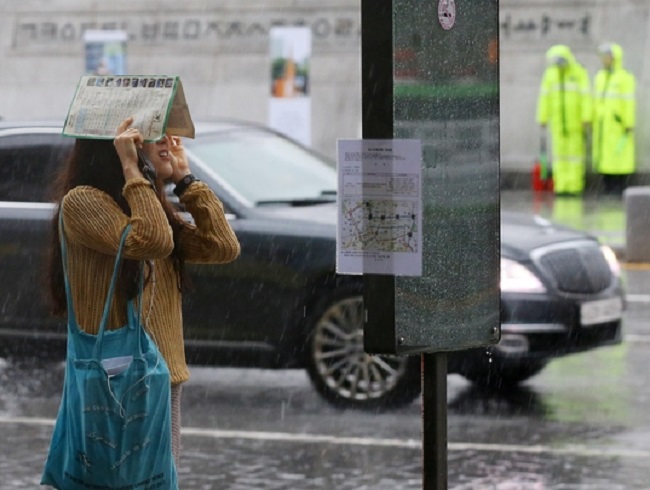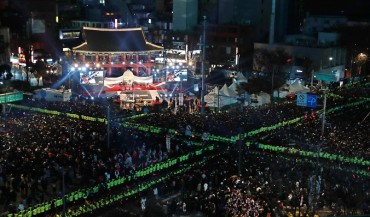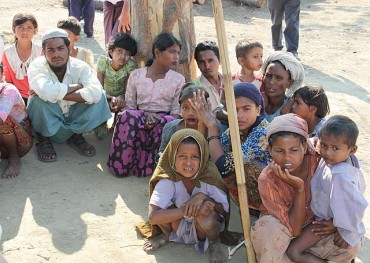
There is a saying that goes, “when the Korea Meteorological Administration organizes an outdoors company retreat, it rains.” (Image: Yonhap)
SEOUL, Aug. 31 (Korea Bizwire) — There is a saying that goes, “when the Korea Meteorological Administration organizes an outdoors company retreat, it rains.” An amusing dig at the national weather agency, it nonetheless encapsulates what a lot of Koreans feel about the Korea Meteorological Administration’s (KMA) predictive prowess.
The feeling is negative, in case the translation doesn’t carry the same sarcastic ring. There may be few things that can unify national sentiment, but a simple Google search using phrases like “Today’s weather prediction: Incorrect” or “Korea Speculation Administration” and the long list of results with often colorful responses may leave digital passersby wondering why the country even runs a national weather organization at all.
Before dismissing such criticisms outright as nothing more than unsubstantiated noise, a recent report from the Board of Audit and Inspection of Korea (BAI) suggests that those anonymous commenters may in fact be on to something.
On August 22, the BAI released the findings of a month long audit conducted from March through April into the KMA (eight other agencies were also included in the audit).
The BAI found that over a five-year period (2012 to 2016), the KMA had predicted rain 5,193 times and had been right 3,228 times, giving it a 62 percent hit rate. The KMA’s threat score, a measure that combines hit rate and the proportion of incorrect forecasts into one number, was calculated to an average of 46 percent over the five-year period (higher threat scores are better).

On August 22, the BAI released the findings of a month long audit conducted from March through April into the KMA (eight other agencies were also included in the audit). (Image: Yonhap)
The mean score actually hides the fact that from 2012 to 2016, the threat score started at 47.7 percent and fell to 45.2 percent.
The BAI emphasized in its report that the means of measuring accuracy and the threat score were different. “The KMA released a statement that its precipitation accuracy rate is over 90 percent, but in a country like ours where rainfall is infrequent, what matters more than accuracy is the threat score.”
The auditors also made a comparison between South Korea’s capabilities and other countries, stating that “South Korea’s threat score is 7 percent lower than the U.K.’s”, even though the KMA is using the same numerical weather prediction model as the U.K.
The seemingly deteriorating capabilities of the KMA is a point of consternation considering the fact that in 2014 the Administration spent 56.9 million won to purchase a supercomputer as part of 119.2 million won invested into computer hardware and prediction model technology within the past five years.
The KMA’s technological travails didn’t end there, as the BAI also found the Administration to have been negligent in developing the correct apparatus to transmute weather readings from satellite feeds into a weather prediction model.

The unending public outcry against the KMA’s repeated forecast blunders and the emergence of an online movement encouraging the use of foreign weather channels forced its hand, according to industry insiders. (Image: Yonhap)
The Administration is operating weather monitoring technology on the South Korean satellite Chollian, which was launched into orbit in 2010, but failed to use it even once to measure the Korean peninsula’s weather patterns before the technology’s seven-year operational lifespan expired in June.
With the BAI’s report spreading like wildfire, the KMA also made a public disclosure on the same day that it would be sending a selected number of its staff to meteorological agencies in foreign countries as a long term move to upgrade its weather-predicting capabilities.
The unending public outcry against the KMA’s repeated forecast blunders and the emergence of an online movement encouraging the use of foreign weather channels forced its hand, according to industry insiders.
Going back to the joke of the KMA’s retreats always being caught in the rain, a reporter for Ilyo News found that the allegations originate from a 1993 article published by Yonhap News titled “This Year’s KMA Outdoors Retreat a Rainy Day, Again”.
When asked about the truth behind such rumors, a spokesperson objected, saying that such claims were unfounded. Though it may have been true many years ago, the spokesperson replied that “it had not rained during an outdoors retreat in the past 10 years.”
Regardless of the truth, the perception of the Administration has taken on a life of its own, and will most likely only be strengthened by the BAI report and the KMA’s own admission of its faults. Though too minor to be seriously considered, voices calling for the privatization of the industry illustrate the disappointment that the public has for the organization. Who knew predicting the future could be so hard?
S.B.W. (sbw266@koreabizwire.com)






